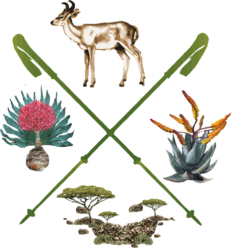Rock Type:
The whole reserve is underlain by rocks of the Klipriversberg formation of the Ventersdorp system. These are Basalt and Andesite – volcanic rocks.
To the north of the reserve lie the quartzites and conglomerates of the upper Witwatersrand system which dip underneath the lavas.
To the south, beyond the Klip River lie the Dolomites of the Transvaal system.
Both the Wits and Transvaal systems were laid down as sediments in shallow seas or deltas and were originally flat lying. They were pushed up by the granite dome to the north of Johannesburg.
The lavas were placed by numerous volcanic fissures over the whole of the areas of the Transvaal and Free State during a period of extreme vulcanism.
Topogaraphy:
The Topography of the area results from the Geology.
The quartzite and lavas are hard, weathering resistant rocks which thus form hills. The Mondeor Valley is formed by the weathering of the weaker contact zone between the Witwatersrand sequence and the Ventersdorp lavas.
The Bloubosspruit valley formed by a tributary of the Klip River cutting back through the hills and finally capturing the stream along the Mondeor dip.
It must be remembered that after the lavas were deposited, the area was covered by rock to a depth of at least 10 km. The pressure of this weight of rock formed quartzites from the sands and gravels of the Witwatersrand system. The present land surface is a very recent surface not more than 5 million years old.
Age of Rock:
- The Wits system is about 2.8 thousand million years old
- The Ventersdorp system is about 2.4 thousand million years old
- The Transvaal system is about 2.1 thousand million years old
The pebbles in the Witwatersrand conglomerates and the gold came from even older rocks which were being eroded at that time.
Variations in the Lava:
The lava forming the hills is not uniform but consists of many kinds of volcanic rock.
These are ordinary lava flows often marked by white inclusions (like pebbles) at the top. These are Amygdales, bubbles caused by the release of gasses in the molten rock which are frozen into position and later fill with silica (quartz).
Tuffs made up of volcanic ash, fossilised pumice and agglomerates of volcanic cinders can also be seen.
At a point near the sewer pipe Collumnar basalts can be seen where the cooling lava shrank to form columns.
In places angular crystals in the lava called Phenocrysts are seen. These indicate that the lava was cooling and crystallising before reaching the surface.
Vegetation:
The soil on the lavas is a clay rich alkaline soil which is extremely fertile in comparison to the acid sandy soil formed on the quartzites to the north.
The ecology of the two environments is affected by this on the lavas. The dominant trees are:
- Acacia Caffra
- Acacia Karroo
- Rus .Leptodicta
- Cussonia Paniculata
On the other quartzites they are:
- Protea Caffra
- Magaliesmontanun -the Stam Vrugt
Uses:
The lavas are quarried for building aggregate to the south west of the reserve.
They weather to round boulders due to their massive structure. These boulders are the primary building material for the iron age ruins in the reserve.
- Being part of the highveld structure the Reserve falls within the summer rainfall area. Average annual rainfall approx. 700mm.
- Temperature variation between hill and valley approx. 1 degree during the day and 4 degrees in reverse at night.
- Rocks of the Klipriviersberg form part of the Ventersdorp system – Basalt and Andesite (volcanic rocks), underlie the reserve.
- Interesting point: Rock formations are known to extend to a depth of 10 km and the existing land surface is comparatively young by comparison — more than 5 million years old.
- Soil types are determined by the rock formations in the area and because of this the soil in the Klipriviersberg tends to be clayey, neutral or slightly alkaline. Whereas the koppies north of Mondeor tend to produce a course sandy soil which is acidic. Hence the reason why vegetation such as Protea prefer the northern slopes.
